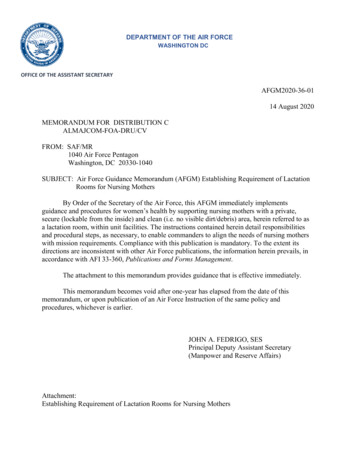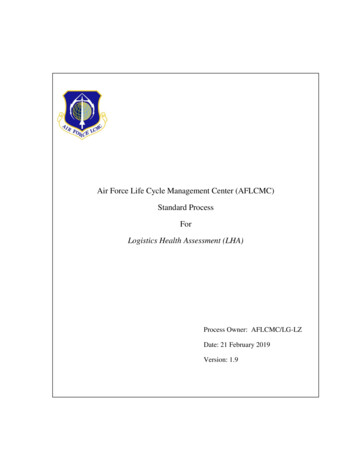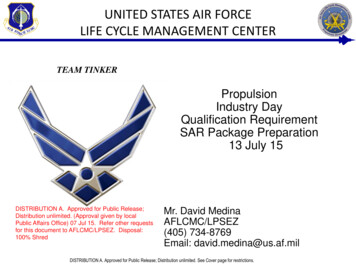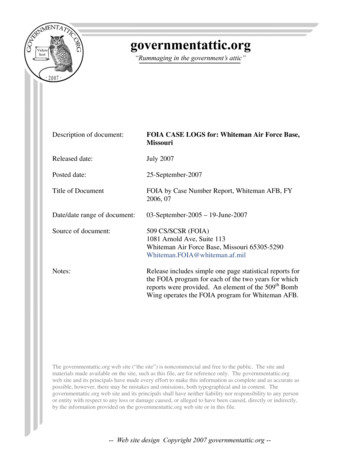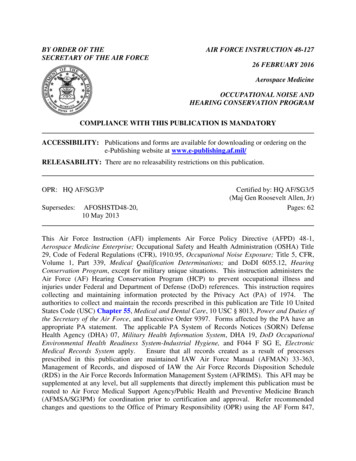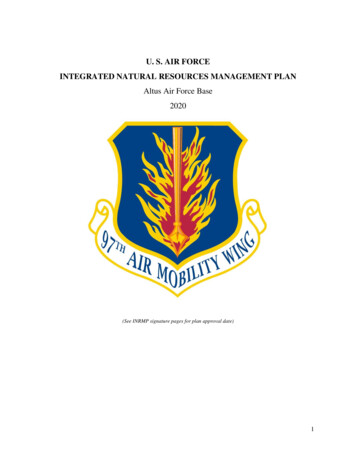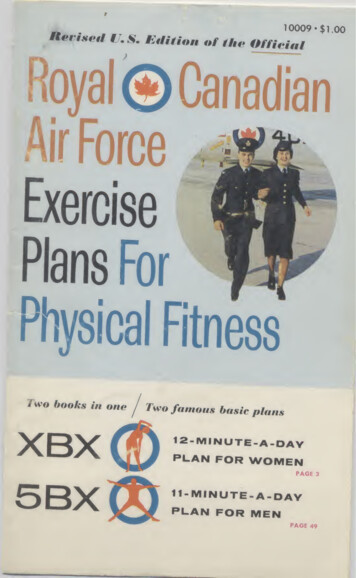
Transcription
,Remsed10009 - 1.00.U.S. Edition of the Officialoyal CanadianAir ForceExercisePlans ForPhysical FitnessTwo booksinone/Two famousbasic plans12-MINUTE-A-DAYPLAN FOR WOMENmPAGE 311-MINUTE- A -DAYPLAN FOR MENPAGE 49
ACKNOWLEDGMENTTheRCAFto theacknowledges the contributions madepreparation of thisRCAFphysical education experts,book bymedical advisers and P.Carey, D.A., Art andJ.RCAFparticularly actheCraft Specialist. In addition,R. Orban, PhD, tothe contribution of W. A.knowledgesthe5BXSection and of N.Education Specialist to theJ.Ashton, BSc,XBXMS,PhysicalSection.Canadian Air Force toThe kind permission of the Royalavailable to the publicmake the text of this training bookisgratefullyacknowledged.by Pocket Books, Inc. byPublished in the United Statesspecialarrangement withTHISWEEK MAGAZINE.CROWN COPYRIGHTThis book, or parts thereof,may not be reproducedform without permission.First Printing140,000Second Printing120,000Third Printing140,000Fourth Printing200,000Fifth Printing100,000Sixth Printing110,000Seventh Printing150,000Eighth Printing100,000Ninth Printing125,000Tenth PrintingEleventh Printing100,000Twelfth Printing100,000Thirteenth Printing100,000100,000Fourteenth Printing 100,000Fifteenth Printing200,000Revised Edition 1962Printed inCanadainany
"Feel Better-Look Better- Now!"Introduction by Roger Duhamel, Queen's PrinterWhen the Royal Canadian Airfitnessprogramon three basicForce went about setting up a physicalin the years followingWorld WarII, itbaseditsplansfacts:a direct result of physical activity; physical fitness physical activity leading to physical fitnessismust be vigorous andregular;people willaccept challenge.RCAFAfter two years of painstaking research, anscientists, physicalandXBXeducation specialists andartiststeam of doctors,produced thePlans for Physical Fitness. These five basic exercises forand ten basicexercises forwomen were5BXmendesigned to provide everyone,no matter what age or physical condition, with the opportunity toachieve and maintain desirable levels of physical fitness.required a very small portion of the day—11Anditonlyminutes for men, 12minutes for women.Theresult hasmade bothfitnessand publishingthere have been innumerable works writtenon theone received with such enthusiasm as the twoin thisbook.When the Office of theauthorities, endorsedsubject, neverwasof exercises offeredCanadian besta few thousand, soon over a hundred thousand,Canadians have taken to theAlthoughQueen's Printer made them availableto the public, the booklets grew into all-timefirstserieshistory.5BX and XBXnowsellers.Atover a millionPlans. Praisedby medicalby Physical Fitness Organizations, the exerciseshave become a daily habit in most Canadian homes.Reports that thefitRCAFhad designed a unique, simple way to keepquickly spread abroad. Requests for information began to pour into
Canada from manyMAGAZINEcountries.In the United States,reported on the publishingTHISWEEKphenomenon and arrangedtooffer the exercises to its 14 million families.In a year, half a million copies were sold by mail,Books, Inc.isalso offering the exercises to theand now PocketAmerican public throughbookstores. This edition follows exactly the Royal Canadian Air Forceedition; not aTheRCAFword has been changed.wayto keepfitisnowyours for only a few minutes ofyour time each day. Read the instructionscarefully, start at theof Chart One, and away you go on the road tobottomFEELING BETTERLOOKING BETTER! fc»ytiQueen's PrinterOttawa, Canadaand
UiiiiJfor?kmmii%mTheXBXPlanFOR WOMEN10 Tested Exercises12 Minutes aTheOfficialRCAFDayFitness Plan
CAUTIONbefore you startIfyou have any doubtas to your capability to under-take this program, see your medical adviserYoushould not performfast,.vigorous, or highlycom-petitive physical activity without gradually developing,andcontinuously maintaining, an adequate level of physicalfitness, particularly ifyou are over the age of 30.
Physical Fitness-WhatMeansitfrequently asked, "What is meant by physicaloffitness?" Technically, physical fitness involves measures and uscular strength andfitness is alsoto activity, agility, balance, co-ordination, and so on. Butmorning;a personal thing. It is how we feel when we get up in theThe questionisare after a hard day's work; how eagerly we lookforward to doing those things which we all like to do picnic, ski orwash floors.those things which we have to dohowtired or freshwe——Each person is her ownwhat it means to her.Why Youbest judge of what physical fitnessShould BeResearch has shown—isandFitthat:the physically fit person is able to withstand fatigue forlonger periods than the unfit;the physically fit personphysical stress;the physicallyfitefficient heart;andisbetter equipped to tolerateperson has a stronger and moreis a relationship between good mental alertness,absence of nervous tension, and physical fitness.thereREMEMBER THAT:weak stomach muscles cause sagging abdomens; andweak back muscles are a major cause of back pain.There are countless reasons for being fit. YOU know how youcan improvefeel. EVERYONE knows how you look. Regular essisnecessary for the fullest enjoyment of living.ReadtheXBXbooklet carefully.
Your AppearanceYour appearance is controlled by the bony frame of your body, andby the proportions of fat and muscle which you have added to it.You cannot do anything about your skeleton, but you can, and should,do something about the fat and muscle.All of us require a certain amount of fat on and in ourbodies forfunctional reasons. Fat softens the bony contours ofthe body; ithelps to keep the body temperature constant; and it actsas an energystorage vault. Fat appears in layers on the outside of thebody, coversand lines the internal organs— the heart and blood vessels, forexampleand it also makes up a part of muscle.—FATExcept for certain neurotic or glandular conditions, people are overbecause they over EAT and under EXERCISE.Muscle is the other controllable factor in the appearance. Whenyoung we are fairly active; the muscles of our bodies are usedand they retain that pleasing firmness—MUSCLE TONE. The lessweexercise muscles the softer and more flabby they become.They becomesmall with disuse, less elastic, and much weaker. Much ofwhat is considered fatness in the abdominal region is nothing morethan weakstomach muscles which permit the internal organs to sag forward.Your muscles perform the same function as a girdle keep them asresilient as your foundation garment.weare—Because the condition of your muscles is so important to thewayyou look and feel, diet alone is not the best method for trying to improveyour body measurements. The best method is a combination of diet andexercise. A thigh that is made up of little muscle and alot of fat mayhave the same measurement as one that has firm muscle and alightfat layer, but—let's face it—it is just not the same thigh.DoThenot confuse good muscle tone with bulky, unsightly muscles.is designed to firm your musclesnot to convert you into aXBXmuscled woman.—
Weight ControlThe major purpose of weight control is to reduce the amount ofon the body and to increase the amount of muscle. It is, in reality,cana program of fat control rather than weight control. This gbe exerted only bybalanced program of exercise.fatWhen we eat, the food is used, stored, or discarded. The bodyand the lessstores fuel, or calories, as fat. The more fuel we consume,in the formbodytheof it we use, then the more of it that is stored inoverflowwillthattankgascar'slikeafat. The human body is notofwhenandfull.Ourstore thosebodies acceptallwhich we do notthe calories thatwe putinto them,use.For example, if you eat food that has a value of 3,000 calories andcaloriesuse only 2,600 of them in your activity, then the remaining 400theseofabout4,000are stored in the body. Every time you accumulatescales.theonweightofpoundcalories you will notice an extraWhen youexerciseyou burncalories.Energy usedin thisslightly heavierwaywillthanfat,muscle development. As musclethanratherweightyourinincreaseyou may very well notice anmuscle weight isa reduction. However it must be stressed that thisfeel.andlookyouwaytheimprovewillanduseful weightisresult inoffResearch has shown clearly that the most effective way of takingweight and keeping it off is through a program which LDAILYdiet.
DietFor many women, the knowledge thatthey have gained a fewa fCW inch6S causes what may be lled the "DietS2E » Z?uCOn UU a medical ex ert the resortPMediP\ yftefvl . is moreately to*to their favourite diet, whichusually a fast. If you wishto go on a stringent diet—consultyour physician first.,5T'n 3VOid the need for resortil, t0 a sy U ct reductiongof foodfoo] intake?v uby !ofthe constant use of sensibledietary habits. In thenorma individual, fat is added to the bodyvery slowly. It may beS V r ren nt hS bef re you notice this radual accumula!8t ion Yon,onYou cannot, hope to takethis fat off and keep it offwithout makingsubtle changes ,n eating and exercisehabits. After a "crash diet"youwill undoubtedly return to yourold habits and, once more, ina fewweeks you will note that IT is back again.TAmchange in diet (along with XBX) cantake off, and keeppounds of excess fat over a period of time.For example 8you eat bread with your meals, eat oneslice less; add a litdelesssugar, or none at all, to your tea orcoffee. The calories so avoidedeachday add up to several thousand in a fewmonths and may be thedifference between the way you look andfeel and the way you wouldlike to look and feel. By the timeyou have arrived at the conditionyou desire your habits will have been changedenough so that you willprobably not slip back into the old ones.off,slightseveral
—What You Can Do About FitnessUnless you are engaged in a full time program of conditioningyou should take part in some form of activefor athletic endeavoursexercise.The average woman is engaged in one of three activities dailyschool, employment, or housework. None of these provides the balancedactivity for the body that is desirable for good physical fitness. Housework, for example, though it may involve a good deal of hard physicallabour, does not take into account the flexibility of the muscles, nor doeswork all the muscles of the body. Day after day you do the sameitThe musclesthings.littlethatworkget plenty of exercise; the others getor none.The same facts that are true of housework also hold true for mostconditionsports. Sports make specific contributions to fitness but do notdo notthe whole body. Most people taking part in a recreational sportvigorously enough to develop adequate levels of fitness. Beforeproducethey become completely effective, even those sports which l round fitnessand more time than the average person can devote to them.pursueitNo matter what you do in your daily life you probably need athegood, balanced program of exercise which will enable you to becomeperson you want to be.Use XBXHow You CanXBX requires little timeDoitalone—at—homeForm your ownand space, and no equipment, so you can:atany time.fitness club.MakeXBXa part of your daily orweekly get together with "the girls".Have your5BXfamilyfor themen.work onItfitness together.can be fun.XBXfor the ladies,
—Why XBX was DevelopedResearch has indicated that Canadians—maleand female, youngand old—are in need of some form of regular,vigorous, physicalactivity. As more and more labour-savingdevices are put into generaluse as more and more people watch moreand more television, moviesand sports events, the amount of physical effortexpended by the averageperson decreases continually.n anaI ? sis of the exercise needs of Canadianswas conducted byspecialists and led to the developmentof the 5BX program formen. XBX is the complementary program forwomen.T, A RCAFTheRCAFanalysis indicated threeexercise:—afirstgreatmajor deterrents to regular&majorityof people would like todo not know how to go aboutwhat to do, how to do it, how often, howexercise, but—itto progress, orsecond—mosthowfar to progress;exercise programs call for the useofequipment and gymnasiums which are notalways available; andthird—most exerciseiture of time,programs call for a great expendwhich most people cannot spare.Clearly a program which resolves theseproblemsXBX Plan does this.XBX tells you what to do,isrequired.Theand howfarwhereyou should progresshow fast you progressto achieve a desirable level ofto start,physical fitness.XBXXBXno equipmentrequiresand veryspace.littletakes only 12 minutesa day.V 10The programisthe restishereupto you.
—How XBX WasXBXisDevelopedofthe product of extensive research into the problemsphysical fitness for girls andwomen.The research was conductedat severalRCAFstationsandin thepopulation.later stages included sections of the civilianages participated in the project.indebted to these persons for their contributions to theOver 600TheRCAFgirlsisandwomenofallprogram.was the administration of a series ofincluded an examination of muscularto activity, andstrength and endurance, testing of heart responsethe physicalteststheseofresultstheFrommeasurement of fat layers.Thefirststep in the projectphysical fitnessneeds offitnesstests.Thetestswomen wereanalyzed.Experiments were carried out with a wide variety of exercises toresults. Manydetermine those most effective in producing the desiredexercises oftenTheineffectual.asdiscardedof these exercises wereprogram.effectiveandbalancedmosttheXBX providedeach exercise were varied until the optimumtime for good results was determined.The timelimits foreach exerciseTests were conducted to arrive at the number of d beexperimental exercise programs were used by severalwas an effective planhundred women. Periodic tests showed thatfitness.generalto improve levels ofThefirstXBXThe program was thenCanada for furtheracrossdistributed to groupstrialand comment. Further modificawere made ontions in the planthe basis of this final fieldTheareresultstrial.of this researchpresented in this bookletPlan for PhysicalRCAF XBXFitness.andto individuals
WhattheXBX PlanIsXBXThePlan is a physical fitness program composed of fourcharts of ten exercises, arranged in progressiveorder of difficulty. Theten exercises on each chart are always performedin the same order,and in the same maximum time limits.inatThe charts are divided into levels. There are 48 levels in all,12each chart. The levels are numbered consecutively, startingwith 1the bottom of Chart I and ending with 48 atthe top of Chart IV.In addition to the regular exercises, two supplementaryexercisesare available for Charts I, II, and III. These exercisesare for the musclesof the feet and ankles and for those muscleswhich assist in themaintenance of good posture.How XBX WorksAny exercise plan or program should work on the basis of aneasy start and gradual progression. As physical fitnessimproves thework load is increased. Theapproach to exerciseXBXfollows theseprinciples.XBX incorporatesfirst——tomakethework loadgreater:the time limit for each exercise remainsthesame in all charts, but the number of timesthe exercise is performed within this time limitissecondtwo methodsincreased at each level within each chart; andthe exercises aremade moredifficultfrom eachchart to the next higher one.Oneach chart you do the same exerciseslevels but increase thetheeach of the twelveAs you move to the next higher chart the exercises arebasicallysame but have been modified and made slightly moredemanding.TheXBX has been planned for gradual,Follow the planDoDo12atnumber of times you do them.not skippainless progression.as outlined in the booklet.levels.not progress faster thanisrecommended.
WhatThethe Exercises Are ForXBXwillimprove your general physical condition by:increasing muscle tone;increasing muscular strength;increasing muscular endurance;increasing flexibility;andincreasing the efficiency of your heart.Each exercise is included because of its contribution in one ormore of these areas.The first four exercises are primarily to improve and maintainare usuallyflexibility and mobility in those areas of the body whichexercisesstrenuousmoreneglected. They also serve as a warm-up for thewhich follow.Exercise 5isfor strengthening theabdominal region and themuscles of the fronts of the thighs.Exercise 6 exercises the long muscles of the back, the buttocks,and the backs of the thighs.Exercise 7 concentrates on the muscles on the sides of the thighs.These muscles get very little work in routine daily activities, or indeedin most sports.Exercise 8 is primarily for the arms, shoulders, and chest, but atthe same time exercises the back and abdomen.Exercise 9 is partly for flexibility in the waist area and for strengthening the muscles of the hips and sides.Exercise 10, the run-in-place with jumping, while exercising thelegs, is primarily for theconditioning of the heart and lungs.The two supplementarymore.Oneexercises are included for those who wishis for strengthening the muscles of theexercisedo aand the ankle joint. The other is for those muscles of the back andabdomen which assist in the maintenance of posture.tolittlefeet13
Whatthe ChartsMeanBelow is an explanation of what the chartpages mean. Check theparagraph headings below with the samplechartonthe opposite page.EXERCISEthe t0pS "In 10. TheT*column headedf mm ?,from1 to fthe chaits are the exercinumbersrefers to Exercise 1, and so on1Theexercises are described and illustratedin the five pages followingeach chart. Exercises 8A and 8B arethe supplementary exercise!described on pages 42 to 44. Ifyou choose to do these, do thembetween Exercises 8 and 9.LEVELThe numbers along the left side of the chartare the levels of theprogram and each refers to the line ofnumbers beside it under theexercise headings. For example atLevel 14 you do Exercise 3 seventimes, Exercise 6 fifteen times, andso on.MINUTES FOR EACH EXERCISEThe allotted time for each exercise isshownnumbered 1 to 4 are the warm-up and all fourhere. The exercisesare to be completed wuhL2 minutes, or about a half minute each. Other examples"Exercise 5akes 2 minutes, and Exercise 6 takes1 minute. The total timefor eacher SeS2 mlnutes II is im Portant that all the"exercises!he done within,v thisSlbetotal timea!until-limit.you can do your presentin the 12 minutes.level,Do not move up to the next levelwithout excessive strain or fatigues'RECOMMENDED NUMBER OF DAYS AT EACH LEVELit isRecord in the box provided on each chart pagethe number of daysrecommended that you spend at each level beforenext. (See instructions for using theplanprogressing to theon page17.)MY PROGRESSThis chart is provided to enable youto keep an accurate recordofyour progress on the way to your physicalfitness goal. Record thedatesyou started and finished each level. Makea note of how you felt asyou did the exercises. To use the bottom chart,select a reasonable aimin tCrmS f b dy measur entsandrecord this in"atAIM.Then record your present measurements onthe START lineWhen you have completed the exercise chart, noteyour latest measure:lmabeUed FINISRt line on the next. The FINISH «ne on one chartwill be the STARTJMYxfTL Note:c Donot expect startling results. Fitnesstakes time and perCouple yourprogram with a good diet andyour progress will be steady.sistence.14XBX
NOTE:This chartisfor illustration only. Charts for use startCHARTon ExerciseforRecommended numberofdaysatMY PROGRESSLEVELeach level
Your Fitness GoalAs is explained in the instructions for the useof the program onthe opposite page, each age groupis given a physical fitnessgoal toattain; that is, a level which theyshould try to reach.The goals indicated in this plan are basedon the average achievements ot girls and women who haveparticipated in itYour goal, then, is the level of fitnessthat the average girl orwoman of your age reached without undue stress,strain, or fatigueaVCrage there are individ "alswhosurpass it, and,.,Tthose who fall Ibelowit. In terms of theplan and the goals thismeans that there will be some women whoare capable of pfog essingbeyond he goal indicated, and on the otherhand, there willperson!f suhswho will never attain this average level.Wf Z?'XBX1IP oalgoal,Lybydifficultyyou fed 3blanallmeans do,t0mLTso.If,fufther throu 8h the charts thanyouron the contrary, you experiencegreatlevel you should stop ata level wffichn approaching thisbe within your capability.feel toIt isrately a level for each individualas guides, and apply them withimpossible to predict Accuthe goalsSwho uses this program. Usecommon sense.F6time aS yOU progress throu h thelevels V ou mayga particular level or exercise. If so,proceed slowlybut keep working at it. (These "plateaus"may occur anywhere in theprogression.) Generally you will be ableto move ahead after a fewdays at this level. If you cannot, thenyou have probably arrived ati»havelJiTJ withudifficultyfit" eSSis ncemed' "S *** **thJSP articular P r g mCautionany reason you stop doing XBX formore than two weeksillness, vacation, or any othercause—DO NOT restart atthe level you had attained before stopping.DO drop back several levelsor to the next lower chart until you finda level which you can do fairlyIf forbecause ofeasily. Physical fitness is lostparticularly trueifduring long periods of inactivitythe inactivity were caused by illnessPv16f\ Thisis
XBX PlanYOUR GOAL for YOUR AGEInstructions for Using theFirst selectLocatecircleitthis level in the chartsor underlinewhich follow.from the table below.Markitinsomeway-it.Record the recommended minimum number of days at eachpage. For example if you are 28in the box provided on each chartIII and you spend ATyears of age, your goal is Level 30 on Chartdays at each level onI,3ChartonLEAST 2 days doing each levelDo not move fasterIII.ChartonleveleachatChart II, and 5 dayslevelthan the recommendedIfYour Agerate.isRecommended MinimumNumber of Days at Each Level onLevelChart Chart Chart ChartYour GoalIt7- 8 years309-10 years3411-12 years3813-14 years4115-17 years4418-19 years4020-25 years3526-30 years3031-35 years2636-40 years2241-45 years1946-50 years1651-55 years11HIIV
CHARTIEXERCISE18A 8B10 022162512121501617Recommended numberofdaysateach level17018J-A20
Exercise 1Start,—ToeTouchingStand erect, feet 12 inches apart, arms over head.Bend forwardto touch floorkneesReturnstraight.betweenfeet.Donot try to keepto starting position.Count. Each return to starting position counts one.Exercise 2—Knee RaisingirStart,Stand erect, hands atsides, feet together.withRaise left knee as high as possible, grasping knee and shinthroughout.straightbackKeepbody.hands. Pull leg towardLowerfoot to floor.Repeat withright leg.Continue by alternating legs—left thenright.CountLeft and right knee raises count one.19
Exercise 3StandStart.—Lateral Bendingerect, feet12 inches apart, hands at sides. Keepingbackbend sidewards from waist to left. Slide lefthand downleg as far as possible. Return tostarting position and bend toright side. Continue by alternatingto left then right.straight,Count Bendsto the leftandright count one.—ArmExercise AStart.Standerect, feet12 inches apart, arms at sides. Make largearm. Do one quarter of total count withforwardcircles and one quarter withbackward circles. Repeat withright arm.circles with leftCount.20CirclingAfullarmcirclecounts one.
—Exercise 5Start.Partial Sit-upsLie on back, legs straight and together, arms atsides.can see yourRaise head and shoulders from floor until youheels.Lower headto floor.Count. Each partial sit-up counts one.—Chest and LegExercise 6Start.Raisingthighs, palmsLie face down, arms along sides, hands underpressing against thighs.Raise head, shoulders, andfloor.KeepRepeatleg straight.chestandas high as possiblefromto floor.raising head, shoulders,Continue by alternatingCount Eachleft legLowerlegs, leftandright leg.thenright.leg raise counts one.21
—Exercise 7SideLeg Raising Start.Lie on side, legs straight, lower armstretched over head alongfloor, top arm used for balance.Raise upper leg 18 to 24 inches. Lowerto starting position.Count. Each leg raise counts one. Dohalf number of counts raisingt0 ther side and do half numberof counts raisin srihtte'—Push-upsExercise 8 -\Start.Lie face down, legs straight and together,hands directly undershoulders.Push bodykneesfloor.moff floor inany way possible, keeping hands andLower bodyJ tocontact with floor. Sit back on heels.Count. Each return to starting positioncounts one.22
—LegExercise 9Start,Liftingarms atLie on back, legs straight and together,sides,palmsdown.floor, or as close toleg until it is perpendicular tothis position as possible.Raiseleftrepeat with right leg.Continue by alternating legs, left then right.Left plus right leg lifts count one.Lower andCountExercise 10—Run and Hopn9Start.Standerect, feet together,armsat sides.raising feet at least fourStarting with left leg, run in placeinches from floor.(When runningin placeliftknees forward, do not merely kickheels backwards.)counts one.Count. Each time left foot touches floorAfter each fifty counts do ten hops.feet leave floor together. Try toHops. Hopping is done so that botheach time.flooroffincheshop at least fourrunning steps are countedonlyIn all run-in-place exercisesNote:repetitions.exercisetowards completing23
ExerciseStart.Standerect, feet1—Toe12 inches apart, arms over head.to touch floorBend forwardBob up and down touchingReturnTouchingbetweenfeet.floor a second time.to starting position.one.Count. Each return to starting position counts—KneeExercise 2Start.Standerect, feet together,armsRaisingat sides.knee and shinRaise left knee as high as possible graspingthroughstraightbackKeepwith hands. Pull leg against body.out.Lowerfoot to floor.Repeat withright leg.Continue by alternating legs—left thenright.Count. Left and right knee raises count one.25
—Exercise 3Start.Standerect, feetLateral Bending12 inches apart, hands at sides.h Ck e% Z /TdownbCnd Sidewards from wais to left. Bob up a fewinches and press sidewards anddown again.Wideleft[ghthand tarting\leg as far as possible.P0Siti nrighted?Continue by alternating toCount. Bends toleftandStanderect, feetleftthenright.right count one.ExerciseStart.3nd rCpeat Same movements to4—ArmCircling12 inches apart, arms at sides.Makelarge circles, with both armsat same time, backwardsand around. Do half the numberof repetitions making backward circles and half making forwardcircles.Count Each26fullarmcircle counts one.
5—Rocking Sit-upsExerciseStart,Lie on back, knees bent, feet onhead.Swing arms forward andmoveto sitting position.floor,arms extended oversame time thrust feet forward andReach forward, trying to touch toesatwith fingers. Return tq starting position.Count Eachreturn to starting position counts one.—Chest and LegExercise 6StartLie face down, arms alongsides,Raisingpalms pressing againstthighs.possible fromRaise head, shoulders, and legs as high asKeepCount Eachlegs straight.Return tofloor.starting position.return to starting position counts one.27
—Exercise 7Side Leg RaisingjlmLStart. Lie on side, legs straight, lower armstretched over head alonefloor, top arm used for balance.Raise upper leg untilitisto this position as possible.perpendicular to floor or as closeLowerto starting position.Count. Each leg raise counts one. Do halfnumber of counts raisingleft leg. Roll to other sideand do half number of counts raising6right leg.ExerciseJStart. 8—KneePush-ups p J Lie face down, legs straight and together,hands directly undershouldersPush body off floor until arms are straightened.Keep hands andfcnees in contact with floor. Try tokeep body in straight line.Count. Each return to starting position countsone.28
Exercise 9—Leg-overs[Lie on back, legs straight and together, arms stretched sidewardsat shoulder level.Start.toRaise left leg to perpendicular. Drop it across body, and tryandperpendiculartolegRaisetoes.withhandtouch rightwith rightreturn to starting position. Repeat same movementsleg.Keep body andlegs straight throughout,and shoulders onfloor.Count Eachreturn to starting position counts one.Exercise 10—Run andStrideJumping7etVJ?Start.After eachJump,!Stand erect, feet together, arms at sides. Starting withrun in place raising feet at least four inches from floor.Count. Each timeStrideileftleft legfoot touches floor counts one.fiftyruns do ten stride jumps.with feet together, arms at sides. Jump so18 inches apart when you land. At theaboutthat feet areraise arms sidewards to shoulderjump,youastimesamejumpStrideJump again sowhen you land.height.sidesstartsthat feet are togetherand arms areat29
CHARTIIIEXERCISE108A 30303634152218404038583719220293433l.13 53113201636353456321630-2002430I2" 019-23 2610 Ifc-42 -242729502325109 -K0 . - Jj Recommended numberof days at each level
ExerciseStart.Standerect, feetBend down1—ToeTouchinghead.about 16 inches apart, arms overfoot.to touch floor outside leftBob up and downagain and bend to touch floorto touch floor between feet. Bobposition.outside right foot. Return to startingcounts one.Count. E
Diet Formanywomen,theknowledge thattheyhavegainedafew S2E»Z?u afCWinch6S ' causeswhatmaybe lledthe"Diet ftefvto*,5 PT \ COn l UU. diet,which ismoreusuallyafast.Ifyouwish togoonastringentdiet—consultyourphysi

